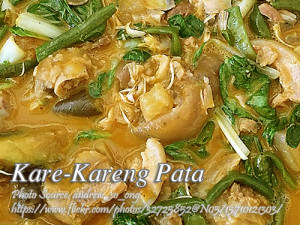Nasi goreng is an Indonesian dish usually served at breakfast. This dish is simply an Indonesian version of “fried rice” and there are many variation of the dish. The dish is usually a combination of fried rice topped with fried egg and served with grilled chicken meat (or other meat such as beef) with peanut sauce. And garnished with fried crackers, cucumber and tomatoes. This version of nasi goreng is served with grilled tenderloin beef in skewers and since it contains pork in the fried rice, it might not be acceptable to Indonesians because they abstain from eating pork.
Nasi Goreng Pinoy Version: A Twist on an Indonesian Classic
When I first heard about nasi goreng, it was during one of those long, laughter-filled family dinners where food often becomes the centerpiece of our stories. My cousin Arnel, who spent a few years working in Jakarta, described it as the ultimate comfort breakfast for Indonesians—a hearty, flavorful fried rice topped with a fried egg and served alongside grilled meats. Inspired by his stories, I decided to create my own version, infused with Filipino flavors that remind me of home.
This Pinoy take on this Indonesian dish is a fusion of Southeast Asian flavors and a nod to our love for pork and barbecue. While traditional nasi goreng is often served with chicken or beef, this recipe adds a Filipino twist with curried fried rice and juicy skewered tenderloin beef. It’s a dish that feels familiar yet adventurous, perfect for beginner cooks looking to try something new.
A Dish with a Rich History
Nasi goreng, which translates to “fried rice” in Indonesian, has a history deeply rooted in practicality and tradition. Like many fried rice dishes across Asia, it was born out of the need to transform leftover rice into something flavorful and satisfying. Over time, it evolved into a beloved staple served not just at home but also in street-side warungs (small food stalls) and high-end restaurants.
What makes it unique is its bold combination of spices and toppings, ranging from sambal (chili paste) to fried shallots. It’s a dish that reflects Indonesia’s diverse culinary influences, from Chinese stir-frying techniques to the use of local spices like turmeric and tamarind.
Preparing the Beef Skewers for Nasi Goreng
For this recipe, I opted for beef tenderloin skewers to complement the curried fried rice. Tenderloin is a great choice because it cooks quickly and stays juicy, even on a hot grill. My uncle Lito, the self-proclaimed barbecue king of the family, taught me the secret to perfectly grilled skewers: marinate the meat thoroughly.
The peanut sauce marinade here is key, blending salty, sweet, and tangy flavors. The addition of calamansi juice in the sauce gives it a uniquely Filipino touch, adding a bright citrusy note that cuts through the richness of the peanut butter. Let the beef sit in the marinade for about 30 minutes to ensure the flavors seep into the meat. Then grill it over medium heat, brushing on more sauce as it cooks to create a glossy, caramelized finish.
Making the Curried Fried Rice
The heart of nasi goreng lies in its rice. While Indonesians often use kecap manis (sweet soy sauce) to flavor their fried rice, I chose curry powder for this version to give it a distinct yet complementary flavor profile. Curry powder works wonderfully here because its warm, earthy spices coat the rice evenly, creating a fragrant and vibrant dish.
Start by sautéing garlic, onions, and chili peppers in a bit of oil until fragrant. My Lola Tess always said the secret to any good fried rice is to let the garlic turn golden—it releases its full flavor this way. Once the onions and chili soften, add in diced pork cubes and stir-fry until browned and fully cooked.
Finally, toss in the rice and curry powder, stirring until every grain is coated with the aromatic spices. Use day-old rice if possible; its drier texture prevents clumping and allows the flavors to soak in better.
Serving Suggestions
Once the curried fried rice is ready, it’s time to assemble the dish. Top the rice with a perfectly fried egg—the runny yolk adds a creamy richness that ties everything together. Arrange the grilled beef skewers on the side and garnish with cucumber slices, fresh tomatoes, and a handful of fried crackers for a crunchy contrast.
This Pinoy nasi goreng is a complete meal in itself, combining protein, carbs, and vegetables in one vibrant plate. It’s best enjoyed fresh off the stove, with a generous drizzle of extra peanut sauce for good measure.
Why These Techniques Work for Nasi Goreng
Marinating the beef in peanut sauce not only tenderizes the meat but also infuses it with deep, nutty flavors that balance the heat of the chili and the tang of the calamansi. Meanwhile, using curry powder in the fried rice creates a bold and aromatic base, enhancing the dish’s overall complexity.
The combination of textures—soft rice, juicy beef, crispy crackers, and creamy egg—makes each bite an adventure. This dish is a beautiful example of how different elements, when prepared thoughtfully, can come together to create something truly special.
A Dish Worth Sharing
Cooking nasi goreng is more than just preparing a meal—it’s a chance to connect with both Filipino and Indonesian culinary traditions. Every time I make this dish, I’m reminded of Arnel’s stories about Jakarta and the joy of experimenting in the kitchen. It’s a recipe that bridges cultures, bringing a taste of Indonesia to our Filipino table.
Whether you’re a beginner cook or a seasoned home chef, this Pinoy version is an excellent way to explore new flavors while staying rooted in the comforting tastes of home. So grab your wok and get cooking—you’ll love the results!
How to Cook Nasi Goreng Pinoy Version
Ingredients
- 200 grams beef tenderloin
- 3 Tbsp. satay peanut sauce see instruction below
- 1 Tbsp. chopped garlic
- 1 pc onion chopped
- 1 pc birds eye chili pepper siling labuyo
- 30 grams pork cubed
- 1 cup steamed rice
- 1 Tbsp. curry powder
- 1 pc egg fried sunny side up
Ingredients for the satay peanut sauce:
- 1 tsp. cooking oil
- 1 pc small red onion chopped
- 1 clove garlic minced
- 1 pc birds eye chili pepper siling labuyo, minced
- 1/4 cup peanut butter
- 1/2 cup water
- 1 Tbsp. calamansi juice
- 1/2 tsp. apple cider vinegar or balsamic vinegar
- 1/2 tsp. brown sugar
Instructions
How to cook Nasi Goreng:
- Cut beef tenderloin into strips or barbecue sizes and skewer into bamboo barbecue sticks.
- Marinate in peanut sauce for about 30 minutes. Grill until done. Set aside.
- Heat a little cooking oil in a pan and saute garlic until fragrant. Then add the onions and chili pepper until soft.
- Add pork cubes and stir fry the meat until brown and cooked.
- Add rice and curry powder and stir cook until rice is evenly coated with curry powder.
- Serve barbecue with curried rice and topped with fried egg.
How to make satay peanut sauce:
- Heat oil in a saucepan and saute onion until soft and golden in color.
- Then add garlic and pepper and saute for about 1 minute.
- Remove from heat and add the peanut butter and mix to combine.
- Add water, calamansi juice, vinegar and sugar. Put in a very low heat and simmer for about 3 minutes stirring constantly to avoid burning the sauce.
Notes
Cooking Tips:
Use Day-Old Rice for the Perfect Texture
Freshly cooked rice can be too moist and sticky, making it difficult to achieve the signature fluffy texture of the rice dish. Day-old rice, stored in the fridge, dries out slightly, which helps it absorb flavors better and prevents clumping during frying. If you don’t have leftover rice, spread freshly cooked rice on a tray and let it cool completely before using.Balance the Heat and Sweetness
It is known for its balance of spicy, savory, and slightly sweet flavors. Adjust the amount of chili peppers based on your spice tolerance, and if you don’t have kecap manis, you can mix soy sauce with a bit of brown sugar as a substitute. Remember, the key is to create a harmony of flavors that complement rather than overpower each other.Cook Ingredients Separately for Even Cooking
Sautéing garlic, onions, and chili first allows their flavors to bloom before adding other ingredients. Cook the pork cubes thoroughly before mixing them with the rice to ensure they are flavorful and tender. By layering each ingredient and seasoning step-by-step, you’ll achieve a well-rounded dish with distinct flavors in every bite.





